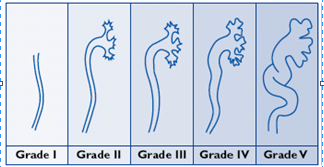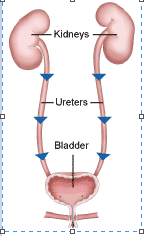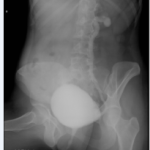Understanding VUR:
Your child has a condition known as Vesicoureteral Reflux (VUR). There are treatments that can help. In this brochure, you will learn about VUR and how it can be treated.
What is VUR?
Urine is produced in the kidneys. Normally, it only flows one way: down the ureters and into the bladder. VUR occurs when urine flows back to the kidney from the bladder through the ureters. This can happen on one or both sides.
What causes VUR?
About 1% of children in the world have VUR. The backward flow can be either due to an intrinsic defect in the valve mechanism at the junction of the ureter and bladder (primary reflux, or it can be because of other causes in the bladder and the outflow urinary tract (secondary reflux). In secondary reflux, the reflux resolves when the causative problem in the bladder or outflow tract is treated.Primary reflux will need to be dealt with on its own merit. In older children, infrequent or incomplete urination, and associated constipation, are significant contributors to VUR.
Is VUR serious?
Reflux by itself is not a serious problem, does not cause infection, and does not cause renal damage. Reflux is considered important to manage, because of its association with urinary infection, and thereby renal scarring, hypertension, or even renal failure. The greater the degree of reflux, the greater are the chances of the kidneys being affected. The grade of reflux can be assessed by doing an MCU, and is graded from I (mild) to grade V (severe). Most of the time, grade I and II VUR (mild) will resolve by itself, as the child grows. Grade III to V are less likely to resolve on their own. The chances of reflux resolving by itself, are inversely proportional to the grade of reflux, the age at detection, and associated bladder and bowel dysfunction.

Testing for VUR
All evaluation for reflux is to evaluate for the presence or absence of urine infection, status of the kidneys, degree of reflux if present, and associated lower urinary tract function. The standard tests include, ultrasound studies which is done in all patients; a special x-ray test called VCUG (voiding cystourethrogram), which is done when the child is passing urine, and an isotope study - DMSA (Dimercapto Succinic Acid) of the kidneys to look for any scarring in the kidney.If the parent has had VUR as a child, there is a 60 % chance that the child will also have VUR. If one child in the family has VUR, there is a 30% chance, that the siblings may have it too. For these reasons, it is important to discuss the testing options with the doctor.
Who should be tested?
Any child with urinary tract infection should be evaluated. Which of the tests will be done for each child, again will depend upon the age of the child, the presenting symptoms, and the report of the ultrasound study. This will vary from patient to patient.Ultrasound studies are not reliable to detect the presence or absence of reflux.
Why should VUR be treated?
Treatment of VUR is both treatment of urine infection, as well as correction of the reflux itself. The goal of treatment of VUR is to protect the kidney from being damaged.
How do I know if my child has VUR?
Symptoms of urinary tract infections include:
- Foul smelling or turbid urine
- Fever
- Abdominal pain
- Burning or pain when urinating
- Frequent and urgent urination
- Urine infection
VUR by itself does not give rise to any symptoms. It is the associated problems that draw attention to the probable presence of VUR. These are urinary incontinence, urine infection, etc.
Infants with infection may not show these signs. Instead, they may have diarrhea, poor feeding, fever, and increased irritability. If there is any question, consult your doctor and have your child’s urine checked. Children can quickly become very sick.
There is help for VUR
It is important to treat VUR to prevent possible infections and kidney damage. There are 3 options for managing or treating VUR:
- Antibiotics may be used to prevent infections until low grade VUR resolves itself as child grows. Children must take medicine every day, and be retested for VUR on a regular basis.
- Surgery can fix the ureters to stop high grade VUR. This type of treatment cures most children.
- In Endoscopic treatment, a substance is injected where the ureter joins the bladder (in low grade VUR).
How do I decide what is the treatment for VUR?
You should discuss this in great detail with your doctor. Antibiotics, surgery, and endoscopic treatment of VUR are all good choices. Your family’s personal views are most important.
Surgery may be favored if VUR is severe or if there are other related medical conditions.
Some families find it hard to do the routine X-ray test and daily medication required with antibiotic treatment.
Your concerns or beliefs matter, therefore it is important to discuss them with your doctor.
Make sure you understand the risks, benefits and follow-up of each treatment.
Is follow up needed?
Regular follow up visits according to protocol is mandatory. This should be discussed with your doctor.
Normal flow of urine


